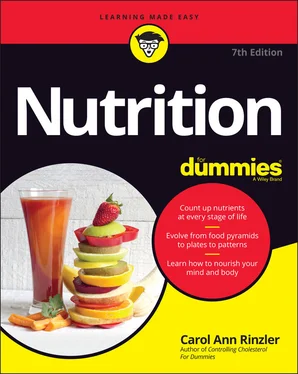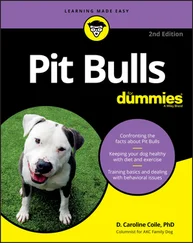Resting energy expenditure (REE)
Even when you’re at rest, your body is busy. Your heart beats. Your lungs expand and contract. Your intestines digest food. Your liver processes nutrients. Your glands secrete hormones. Your muscles flex, usually gently. Cells send electrical impulses back and forth among themselves, and your brain continually sends messages to every tissue and organ.
TABLE 5-1How Many Calories Do You Need When You’re Resting?
| Gender and Age |
Equation to Figure Out Your REE |
| Males |
|
| 18–30 |
(15.3 x weight in kg) + 679 |
| 31–60 |
(11.6 x weight in kg) + 879 |
| 61 and older |
(13.5 x weight in kg) + 487 |
| Females |
|
| 18–30 |
(14.7 x weight in kg) + 496 |
| 31–60 |
(8.7 x weight in kg) + 829 |
| 61 and older |
(10.5 x weight in kg) + 596 |
The National Research Council, Recommended Dietary Allowances (Washington, D.C.: National Academy Press, 1989)
The energy that your resting body uses to do all of this is called resting energy expenditure, abbreviated REE. The REE, also known as the basal metabolism, accounts for 60 to 70 percent of all the energy you need each day.
To find your resting energy expenditure (REE), you must first figure out your weight in kilograms (kg). One kilogram equals 2.2 pounds. So to get your weight in kilograms, divide your weight in pounds by 2.2. For example, if you weigh 150 pounds, that’s equal to 68.2 kilograms (150 ÷ 2.2). Plug that into the appropriate equation in Table 5-1, and there’s your REE.
What do you do with this information? First, simply appreciate its scientific value in describing the most basic fact about how many calories you need to survive. Second, and more pragmatically, regard it as a base on which to build a nutritional, real-life daily menu.
Sex, glands, and chocolate cake
A gland is an organ that secretes hormones — chemical substances that can change the function and sometimes the structure of other body parts. Hormones secreted by three glands — the pituitary, the thyroid, and the adrenals — influence how much energy you use when your body’s at rest.
Your pituitary gland, a small structure in the center of your brain, stimulates your thyroid gland (which sits at the front of your throat) to secrete hormones that impact the rate at which your tissues burn nutrients to produce energy.
When your thyroid gland doesn’t secrete enough hormones (a condition known as hypothyroidism ), you burn food more slowly, and your REE drops. When your thyroid secretes excess amounts of hormones (a condition known as hyperthyroidism ), you burn food faster, and your REE is higher.
When you’re frightened or excited, your adrenal glands (two small glands, one on top of each kidney) release adrenaline, the hormone that serves as your body’s wake-up call. When you release adrenaline, your heartbeat increases. You breathe faster. Your muscles clench. And you burn food faster, converting it as fast as possible to the energy you need for the reaction commonly known as fight or flight. But these effects are temporary. The effects of your sex glands, on the other hand, last as long as you live.
If you’re a woman, you know that your appetite may rise and fall in tune with your menstrual cycle. In fact, this fluctuation parallels what’s happening to your REE, which goes up just before or at the time of ovulation. Your appetite is highest when menstrual bleeding starts and then falls sharply. Being a man (and making lots of testosterone) makes satisfying your nutritional needs on a normal American diet easier. Your male bones are naturally denser, so you’re less dependent on dietary or supplemental calcium to prevent osteoporosis (severe loss of bone tissue) later in life. You don’t lose blood through menstruation, so you need only less than half as much iron (8 milligrams for an adult male; 18 milligrams for a premenopausal woman who is neither pregnant nor nursing). Best of all, you can consume about 10 percent more calories than a woman of the same weight without adding pounds.
It is no accident that while teenage boys are developing wide shoulders and biceps, teenage girls are getting hips. Testosterone, the male hormone, promotes the growth of muscle and bone. Estrogen gives you fatty tissue. As a result, the average male body has proportionally more muscle; the average female body, proportionally more fat.
Muscle is active tissue. It expands and contracts. It works. And when a muscle works, it uses more energy than fat (which insulates the body and provides a source of stored energy but does not move an inch on its own). What this muscle versus fat battle means is that the average man’s REE is about 10 percent higher than the average woman’s. In practical terms, that means a 140-pound man can hold his weight steady while eating about 10 percent more than a 140-pound woman who is the same age and performs the same amount of physical work.
 No amount of dieting changes this unfair situation. A woman who exercises strenuously may reduce her body fat so dramatically that she no longer menstruates, an occupational hazard for some professional athletes. But she’ll still have proportionately more body fat than an adult man of the same weight. If she eats what he does, and they perform the same amount of physical work, she still must take in fewer calories than he to hold her weight steady.
No amount of dieting changes this unfair situation. A woman who exercises strenuously may reduce her body fat so dramatically that she no longer menstruates, an occupational hazard for some professional athletes. But she’ll still have proportionately more body fat than an adult man of the same weight. If she eats what he does, and they perform the same amount of physical work, she still must take in fewer calories than he to hold her weight steady.
MUSCLE VERSUS FAT VERSUS WEIGHT LOSS
Muscle weighs more than fat. This is why many people who take up exercise to lose weight discover, one month or so into the barbells and step-up-step-down routine, their clothes fit better, but the scale points slightly higher. They’ve traded lightweight fat for heavier muscle, a case where less is more that can be momentarily confusing but definitely healthier in the long term.
Your second largest chunk of energy after the REE is the energy you spend on physical work, everything from brushing your teeth in the morning to planting a row of petunias in the garden or working out in the gym.
Your total energy requirement (the number of calories you need each day) is your REE plus enough calories to cover the amount of work you do.
Does thinking about this use up energy? Yes, but not as much as you’d like to imagine. To solve a crossword puzzle, or write a chapter of this book, the average brain uses about 1 calorie every four minutes. That’s only one-third the amount needed to keep a 60-watt bulb burning for the same length of time.
Table 5-2defines the energy level of various activities ranging from the least energetic (sleep) to the most (playing football, digging ditches). Table 5-3shows how to make these numbers personal.
TABLE 5-2How Active Are You When You’re Active?
| Activity Level |
Activity |
| Resting |
Sleeping, reclining |
| Very light |
Seated and standing activities, painting, driving, laboratory work, typing, sewing, ironing, cooking, playing cards, and playing a musical instrument |
| Light |
Walking on a level surface at 2.5 to 3 mph, garage work, electrical trades, carpentry, restaurant trades, housecleaning, child-care, golfing, sailing, and table tennis |
| Moderate |
Walking 3.5 to 4 mph, weeding and hoeing, carrying a load, cycling, skiing, tennis, and dancing |
| Heavy |
Walking with a load uphill, tree felling, heavy manual digging, basketball, climbing, football, and soccer |
| Exceptionally heavy |
Professional athletic training |
The National Research Council, Recommended Dietary Allowances (Washington, D.C.: National Academy Press, 1989)
Читать дальше

 No amount of dieting changes this unfair situation. A woman who exercises strenuously may reduce her body fat so dramatically that she no longer menstruates, an occupational hazard for some professional athletes. But she’ll still have proportionately more body fat than an adult man of the same weight. If she eats what he does, and they perform the same amount of physical work, she still must take in fewer calories than he to hold her weight steady.
No amount of dieting changes this unfair situation. A woman who exercises strenuously may reduce her body fat so dramatically that she no longer menstruates, an occupational hazard for some professional athletes. But she’ll still have proportionately more body fat than an adult man of the same weight. If she eats what he does, and they perform the same amount of physical work, she still must take in fewer calories than he to hold her weight steady.










